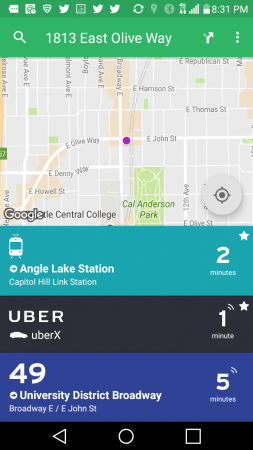Uber Invests In the Future, Endorses ST3

BY SEATTLE SUBWAY
"Double down on cars and buses." That has essentially been the "No" campaign's position in opposition to Sound Transit 3's mix of light rail, commuter rail and BRT. Despite the likelihood of 800,000 more residents here by 2040, the opposition assumes, without showing their math, that self-driving cars can make rail obsolete within 20 years. Though experts say it's too soon to tell how autonomous vehicles will impact traffic flow and volumes, transit opponents promise us that autonomous Ubers are going to fix everything by themselves, perhaps combined with buses stuck in traffic next to them.
Well, Uber came out with a surprising statement a week ago Monday:
Uber is dedicated to the future of cities-to making transportation reliable everywhere, for everyone. What we provide will just get us part of the way there, though. To fully realize the vision, we need strong partners among transit agencies and local governments. This is why we are urging voters to support Proposition 1. [emphases ours]
Uber joined the ranks of Amazon, Alaska Airlines, Microsoft, Vulcan, Costco, Expedia, and other companies proclaiming ST3 as critical to our region's future. But Uber's endorsement particularly stands out. As the undisputed market leader of app-based ride hailing, the company set aside its own non-endorsement traditions to support the nation's largest transit-only measure. It was the first prominent and explicit political recognition by Uber that ride hailing apps and transit need each other. But you are likely to see opponents continue to make magical claims that the company itself no longer supports.
The statement aligns Uber and Sound Transit's objectives, both seeking to "reduce congestion and pollution by moving more people with fewer cars, and provide better mobility options for all people living in the region." In Seattle, facets of mobility and affordability account for 6 of the top 12 issues on people's minds, according to an open ended question posed by Strategies 360 earlier this year.
At a certain point in our history, if you wanted milk, you had to own a cow. Similarly today, if many people want to have reliable transportation, they have to own a car. This has a growing cost, especially in a region where space is coming at a premium. The average Seattleite spends approximately $10,000 per year on transportation. While some people spend far less by riding transit, others spend significantly more. It eats into 15% of individual budgets, or nearly 20% for the average family. The cost is also proportionally higher for those with the least means to pay.
There are also the human and environmental costs of our obligatory car culture. Nearly half of Washington's CO2 emissions come from transportation (3/4 of which are caused by gas or diesel engines). While auto fatalities are half what they were in the 1960's, they recently began rising again, with an increasing culture of distraction to blame. And we are losing precious time in our lives, including 106 lifetime days searching for parking and an hour per day behind the wheel.
How do we reduce these costs? The answer is for people to have real choices that are cheaper than having to drive themselves to work or even own a car. That's why a robust and resilient system that has these choices is essential to building a more affordable, more just, and more sustainable community. To be robust and resilient, we actually need both great transit and effective ridesharing. As Uber attests, one does not accomplish this without the other.
At its best, the sharing economy can reduce the cost of traveling by car by eliminating the necessity of ownership and the sunk costs that entails. Using Uber, Lyft, Car2Go, or Reach Now as a complement to a transit-first lifestyle, you no longer have to pay to own a vehicle that sits motionless 95% of the time. These technologies are far more scalable than mass car ownership, but also far less scalable than high-capacity transit. To the extent technology can reduce ownership and increase consumer choice, it can substantially improve our baseline. But if we used tech as an excuse to divest from transit, that could actually make things worse.
Our cities aren't going anywhere, and trends point to their continued densification and success. There is no better tool to move lots of people quickly than a train operating in its own right-of-way. Simple geometry means that cars, autonomous or not, are not going to overcome this. Meanwhile, the low-cost Uber of the future will complement transit by serving places where density is insufficient to warrant fixed-route transit. If we simply allow each mode to do that which it does best, then everybody wins.
And we don't have to look far to understand how it might work. Take the Bay Area, for example, where 10% annual growth in Caltrain ridership last year coincided with 153% growth in Uber trips to and from the same Caltrain stations. Separate studies make clear that people who use services like Uber are more willing to both forego a car and also ride transit more frequently.
To make this work out in our favor, we need resilience. Our various tormentors, whether construction, bad weather, overturned fish trucks, etc, prove that our over reliance on an open system (mixed bus and car traffic) leaves our network brittle. Population growth will only make this worse.
Uber, unions, countless major regional employers, the social justice community, and regional political leaders are uniting around a solution to our transportation woes. A robust network of fast, reliable transit, paired with shared vehicles, and people walking and biking. These synergies will make our region more affordable, sustainable, and maintain the high quality of life we have come to expect. Like Uber said, it takes ST3 to help get us there. Vote Yes.